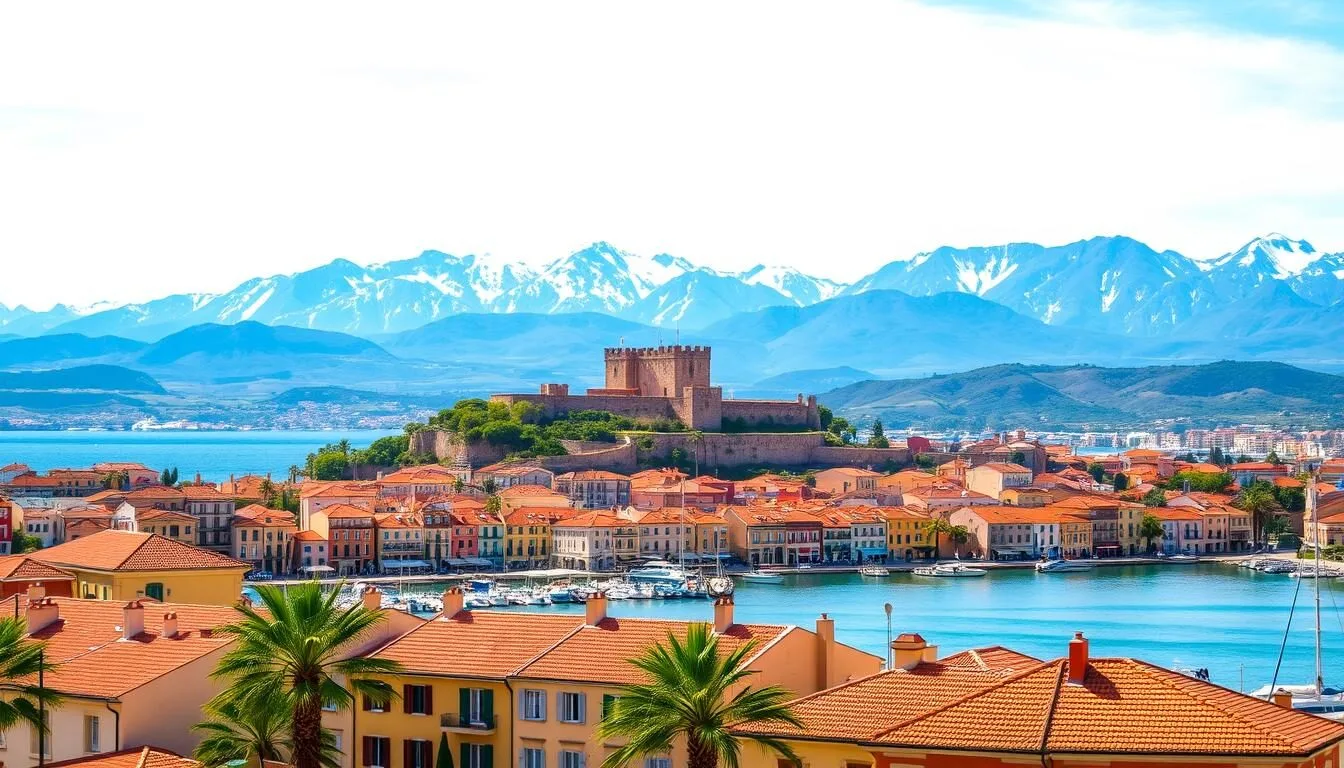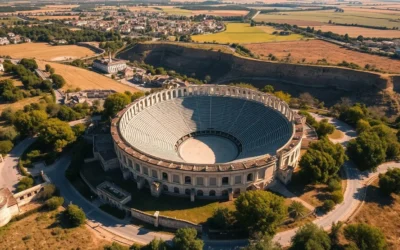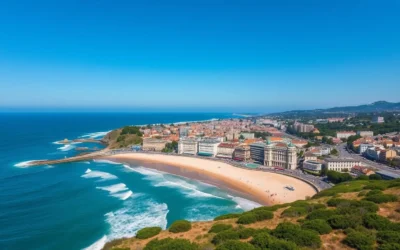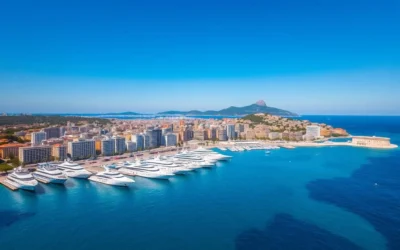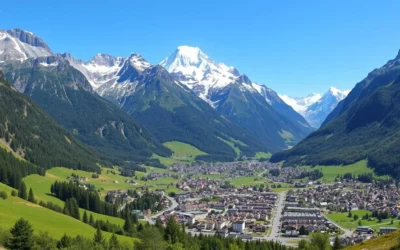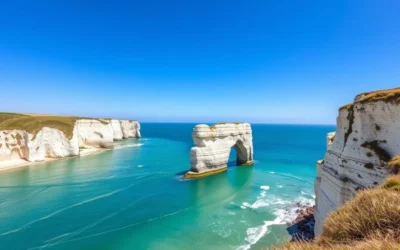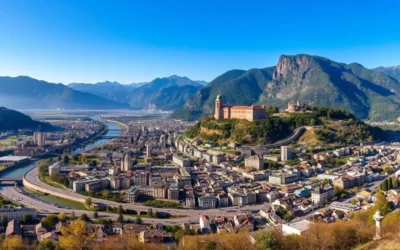✓ Accommodations✓ Flights✓ Rental Cars✓ Tours & Activities
Imagine strolling through the streets of a city that seamlessly blends Mediterranean charm with imperial history. Ajaccio, the capital of Corsica, is a treasure trove of cultural, natural, and diverse heritage.
As you visit this captivating city, you’ll be enchanted by its rich historic past, excellent gastronomy, and remarkable architecture. From the birthplace of Napoleon Bonaparte to the iconic sites of the Imperial City, there’s no shortage of exciting experiences to be had.
You’ll explore the best things to see and do, from historical sites to beautiful beaches and culinary delights. This comprehensive guide will help you make the most of your visit to Ajaccio, ensuring an unforgettable trip to one of France’s most historically significant destinations.
Discovering the Imperial City of Corsica
As you step into Ajaccio, the imperial heritage of Corsica unfolds before your eyes, revealing a city steeped in history and culture. Ajaccio’s rich historic past, excellent gastronomy, and remarkable architecture will enchant you with its cultural, natural, and diverse heritage.
As you stroll the streets of the city, you’ll notice that many monuments and streets are dedicated to the Emperor Napoleon Bonaparte, born here on August 15, 1769. The city’s unique blend of French and Corsican cultures creates a distinct atmosphere that’s different from mainland France.
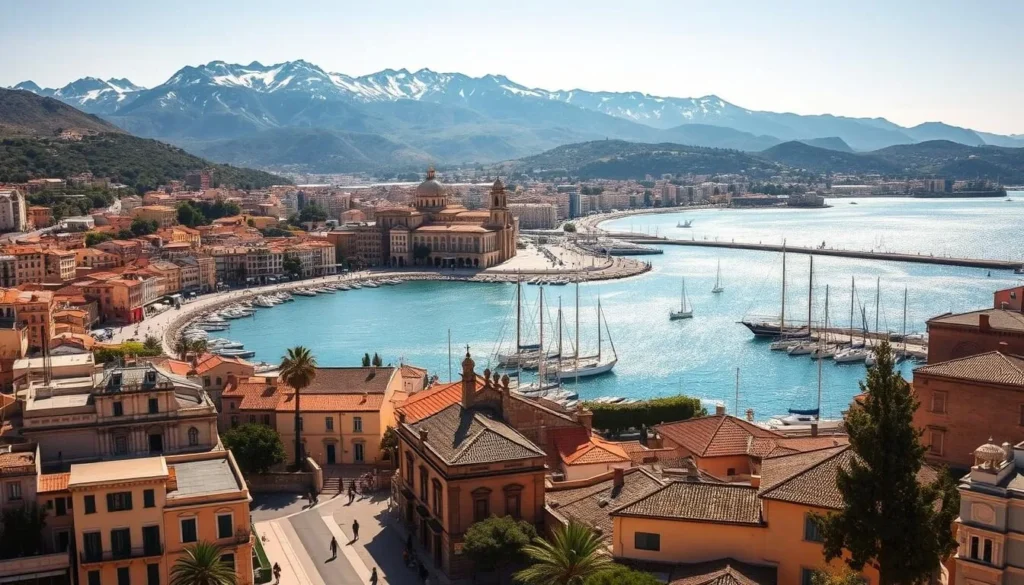
The historic districts of Ajaccio will transport you back in time, with architecture from various periods telling the story of the city’s evolution. The Mediterranean climate makes Ajaccio a year-round destination, with the best time to visit being during spring and fall when temperatures are pleasant and crowds are thinner.
| Aspect | Description |
|---|---|
| Cultural Heritage | Ajaccio proudly wears its imperial heritage, with numerous monuments dedicated to Napoleon Bonaparte |
| Natural Beauty | The city boasts remarkable natural beauty, positioned on the Gulf of Ajaccio, surrounded by mountains and blessed with stunning beaches |
| Local Cuisine | The local cuisine combines traditional Corsican specialties with Mediterranean influences and fresh seafood |
Ajaccio offers a perfect blend of history, culture, and natural beauty, making it a fascinating destination to explore.
Ajaccio, France: Best Things to Do – Top Picks
As you explore Ajaccio on foot, you’ll uncover the charm of this Corsican town, from its narrow streets to its stunning coastline. The city’s compact center makes it easy to navigate, allowing you to soak in the authentic atmosphere and discover hidden gems.
When you visit Ajaccio, consider allocating at least 2-3 days to fully appreciate its diverse range of attractions. The city’s Mediterranean climate makes it enjoyable year-round, though spring and fall offer more comfortable temperatures for sightseeing.
Some valuable tips for your visit include visiting the market early in the morning for the freshest produce and taking advantage of free museum days. Exploring the coastal paths will provide you with spectacular views of the gulf.
| Activity | Location | Tips |
|---|---|---|
| Walking Tour | Town Center | Explore on foot to discover hidden gems |
| Visit Market | Local Market | Go early for fresh produce |
| Take a Tourist Train | Major Attractions | Learn about the city’s history and landmarks |
For the best things to do, don’t miss the opportunity to experience local life by visiting cafés where you can sample traditional dishes like figatellu and brocciu cheese. For the best photos, head to viewpoints like Place d’Austerlitz during golden hour.
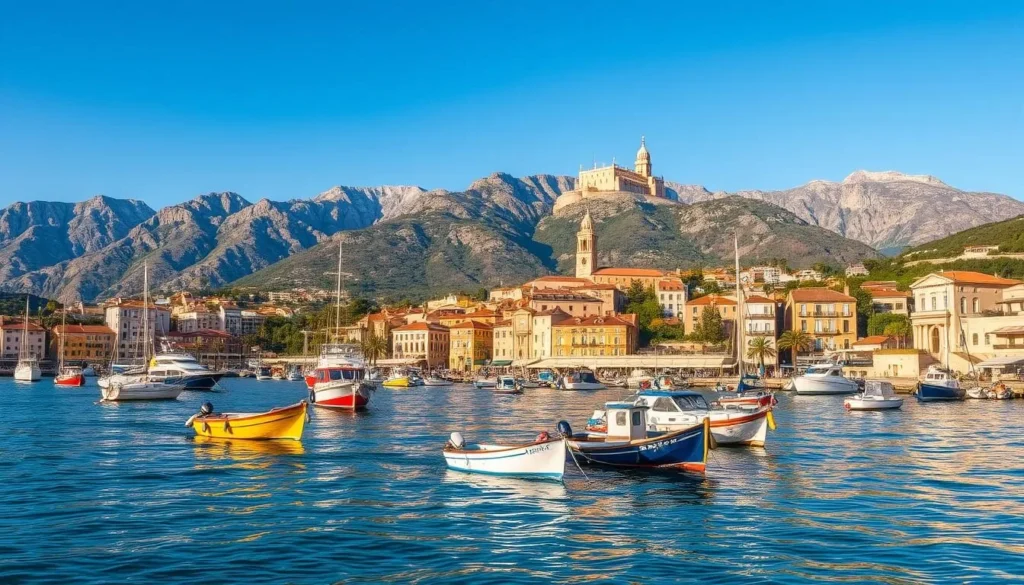
In summary, Ajaccio offers a perfect blend of historical discovery, cultural immersion, and natural beauty, making it one of Corsica’s most captivating destinations. Whether you’re exploring the town on foot or using the tourist train, you’re sure to have a memorable experience.
Maison Bonaparte: Birthplace of an Emperor
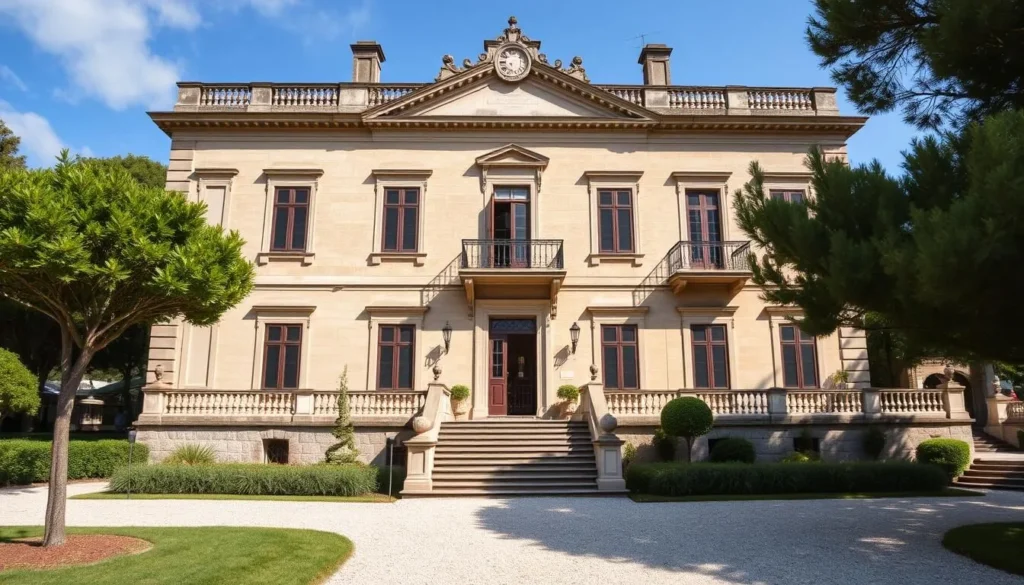
Step into the past at Maison Bonaparte, the 18th-century house that gave birth to one of history’s most famous leaders. This historic house museum is a must-visit attraction in Ajaccio, offering a unique glimpse into the life and times of the Bonaparte family.
The Family Home and Its Historical Significance
Maison Bonaparte stands as one of Ajaccio’s most significant historical sites, preserving the actual home where Napoleon Bonaparte was born on August 15, 1769. The museum offers a fascinating glimpse into the daily life of the Bonaparte family before Napoleon’s rise to power, with meticulously preserved rooms showcasing period furniture and personal artifacts.
What to See Inside the National Museum
As you explore the various rooms of the musem, you’ll walk through the very room where Napoleon was born, creating a tangible connection to one of history’s most influential figures. The museum’s collection includes family portraits, documents, and personal items that help illustrate the Bonaparte family’s Corsican roots and their place in local society. Informative displays provide context about Napoleon’s childhood and how his early years in Ajaccio shaped his later military and political career.
Palais Fesch Museum of Fine Arts
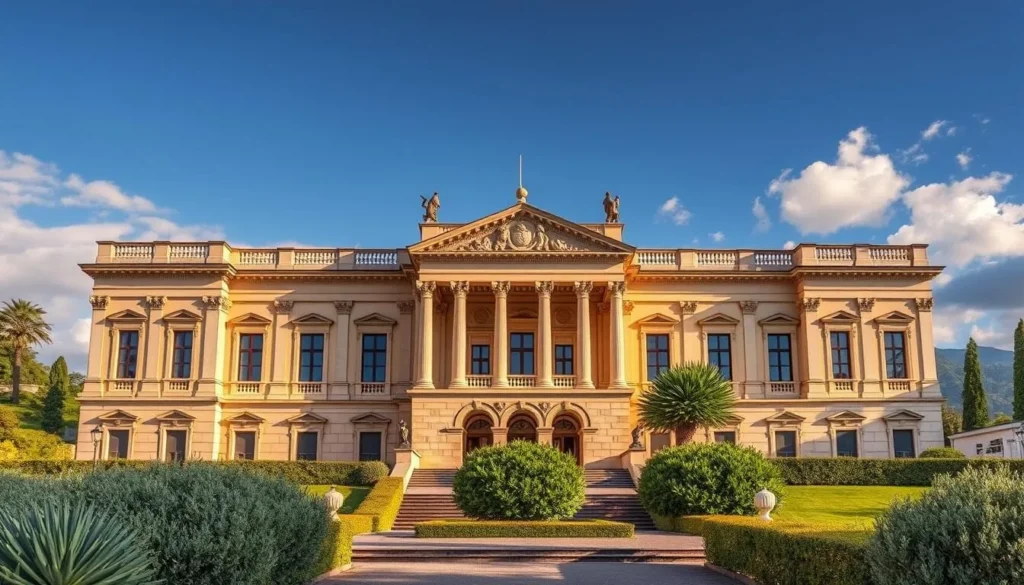
The Palais Fesch Museum of Fine Arts, established by Cardinal Fesch, Napoleon’s uncle, is a significant cultural landmark in Ajaccio. Recently renovated, the museum holds “museum of France” status and brings together three major collections: Italian Masters, the Napoleonic Collection, and Corsican painters.
Italian Masters and Napoleonic Collections
The Palais Fesch Museum of Fine Arts houses one of France’s most impressive art collections outside Paris. You’ll be amazed by the museum’s collection of Italian Primitive paintings from the 14th-15th centuries, considered the most significant collection outside the Louvre in Paris. The Napoleonic Collection offers fascinating insights into the Emperor’s life and legacy through portraits, memorabilia, and historical artifacts.
The Imperial Chapel
The Imperial Chapel, located adjacent to the Palais Fesch, serves as the final resting place for members of the Bonaparte family, creating a solemn complement to the artistic treasures in the main museum. The architecture of the Palais itself is worth admiring, with its grand neoclassical design reflecting the imperial ambitions of the Bonaparte era.
Recent renovations have enhanced the visitor experience with improved lighting, informative displays in multiple languages, and comfortable spaces to appreciate the artistic masterpieces. As you explore the museum, you’ll discover works by renowned Italian masters, including Botticelli, Titian, and Bellini, displayed in chronological order to show the evolution of Italian painting.
Exploring Ajaccio’s Old Town
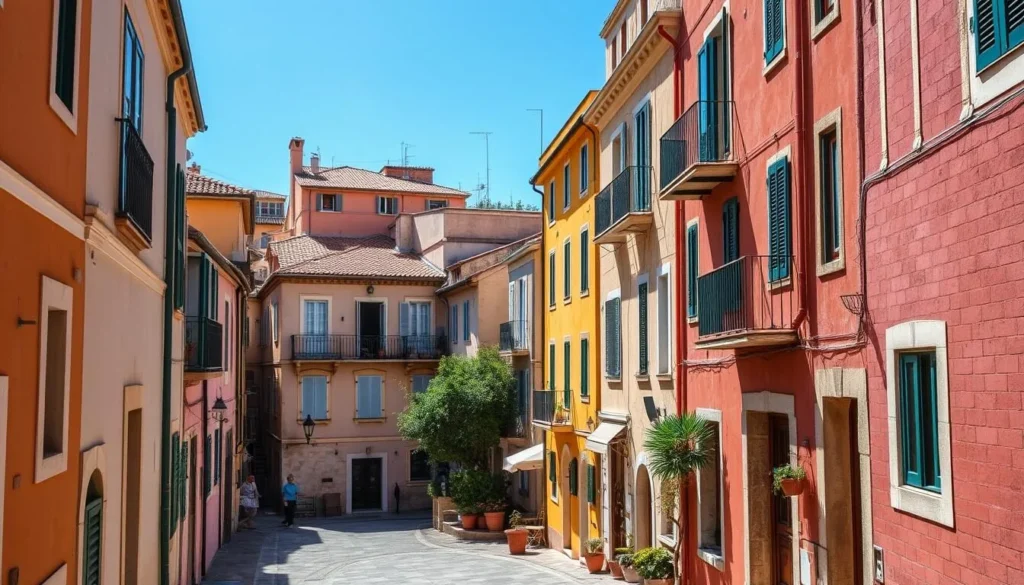
Wandering through Ajaccio’s Old Town is like stepping into a charming labyrinth of discovery. The historic district is a treasure trove of experiences, with its narrow, winding streets inviting you to get pleasantly lost while discovering the authentic heart of the city.
Winding Streets and Local Culture
As you wander through this historic district, you’ll encounter colorful buildings with shuttered windows, small squares with bubbling fountains, and unexpected views of the sea that appear at the end of narrow alleyways. The local culture comes alive in the Old Town, where you might stumble upon impromptu gatherings of Ajaccians singing traditional Corsican polyphonic songs, especially in the evening hours around Rue de Rome.
Best Shops, Restaurants, and Wine Bars
Boutique shopping in the Old Town offers unique souvenirs beyond typical tourist trinkets. Look for authentic Corsican products like handcrafted knives, local honey, essential oils, and artisanal jewelry. The restaurant scene ranges from humble family-run establishments serving traditional Corsican cuisine to sophisticated dining venues offering contemporary interpretations of local specialties. Wine enthusiasts will appreciate the cozy wine bars scattered throughout the Old Town, where knowledgeable staff can introduce you to Corsica’s distinctive wines made from indigenous grape varieties like Sciaccarellu and Niellucciu.
The best way to experience the Old Town is without a rigid itinerary – simply follow your curiosity down interesting streets, stop for coffee at a local café, and embrace the relaxed Mediterranean pace of life.
Ajaccio Market and Place Campinchi
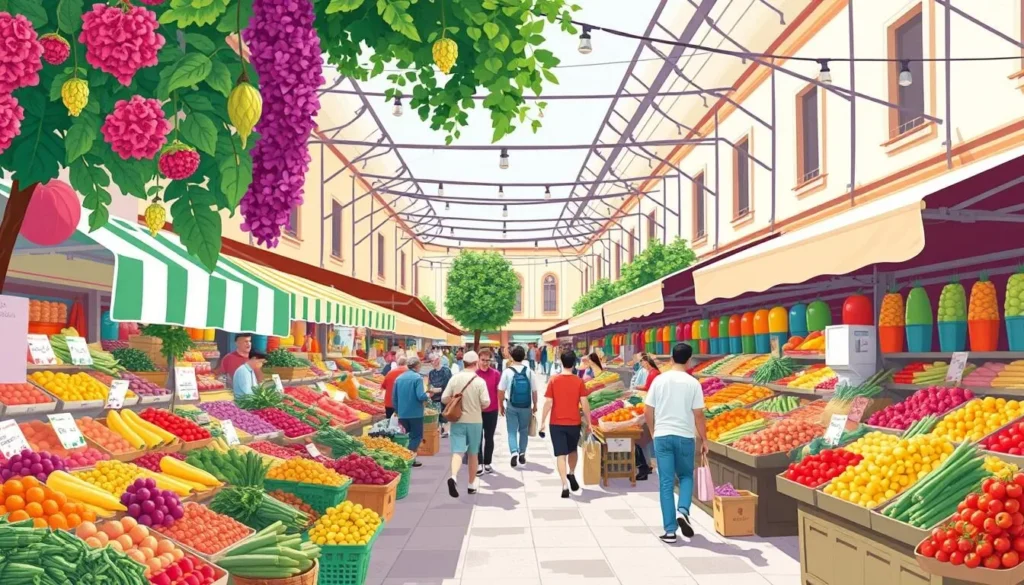
Immerse yourself in the sights, smells, and tastes of Ajaccio at the bustling market. The vibrant Ajaccio Market is a feast for all senses, operating every day of the year and showcasing the island’s incredible culinary heritage in one bustling location.
Local Delicacies and Fresh Produce
You’ll find yourself surrounded by colorful stalls displaying mountains of seasonal produce, from fragrant Corsican clementines and figs to wild asparagus and chestnuts, depending on when you visit. The market is not just a place to shop but a cultural experience where you can observe locals debating the quality of food and engaging in the traditional Corsican art of conversation.
The Producers’ Hall and Fishmonger’s Stall
The recently renovated Producers’ Hall has become a food paradise where local artisans sell their specialties – don’t miss trying the prisuttu (Corsican ham), figatellu (liver sausage), and the island’s distinctive cheeses like brocciu. Seafood enthusiasts should head straight to the fishmonger’s stall, where the day’s fresh catch from the Mediterranean is displayed on beds of ice.
After exploring the market, head to Place Campinchi next to the market, where you can get a superb view of the Napoleonic quays. For the best experience, visit the market early in the morning (before 10 am) when produce is freshest and before the crowds arrive.
Beautiful Beaches Around Ajaccio
You’ll find a diverse range of beautiful beaches around Ajaccio, from secluded coves to bustling city center spots. Ajaccio’s beaches can easily be reached from the city centre, allowing you to leave your car behind and head to the sands by electric bike or scooter.
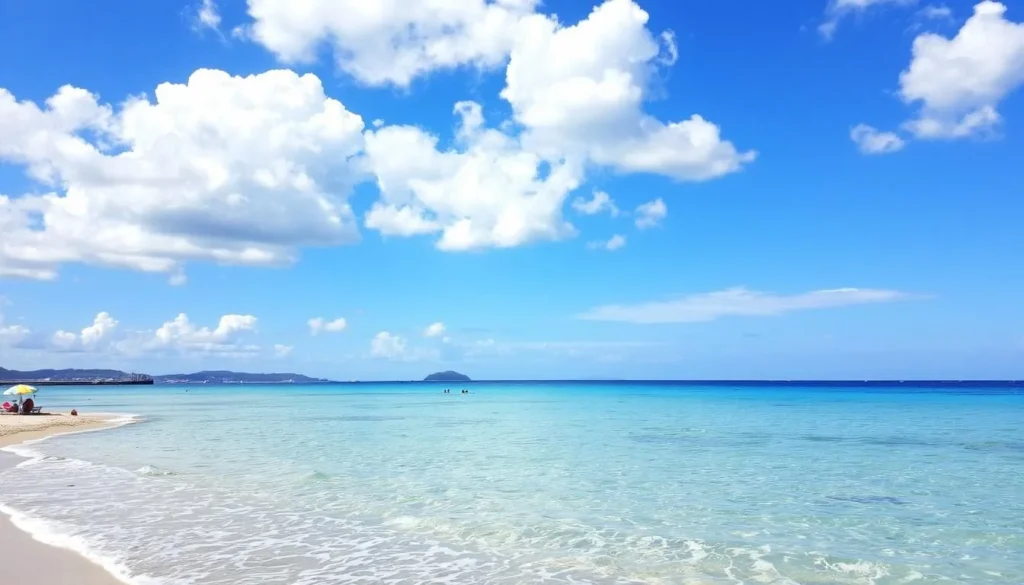
City Center Beaches for Convenience
The city center beaches offer remarkable convenience – you’ll find yourself just steps from cafés, restaurants, and shops while still enjoying the crystal-clear waters of the Mediterranean. These beaches are perfect for those who want to enjoy the sea without straying far from the city’s amenities.
Capo di Feno and Campo dell’Oro
For a different experience, head to Capo di Feno, ideal for surfers, or Campo dell’Oro, perfect for families. Capo di Feno, about 15km from the city center, boasts consistent waves and stunning natural surroundings, making it a haven for both beginner and experienced surfers. Meanwhile, Campo dell’Oro beach provides gentle slopes into the sea and fine sand, ideal for building castles, along with nearby facilities like restrooms and snack bars.
Ajaccio is blessed with an abundance of beautiful beaches, ranging from convenient city center stretches to wild, unspoiled coves. The clear waters offer excellent snorkeling opportunities, allowing you to observe Mediterranean fish and underwater rock formations. Whether you’re looking to relax or be more energetic, Ajaccio’s beach options have something for everyone.
San Roccu Cathedral and Religious Heritage
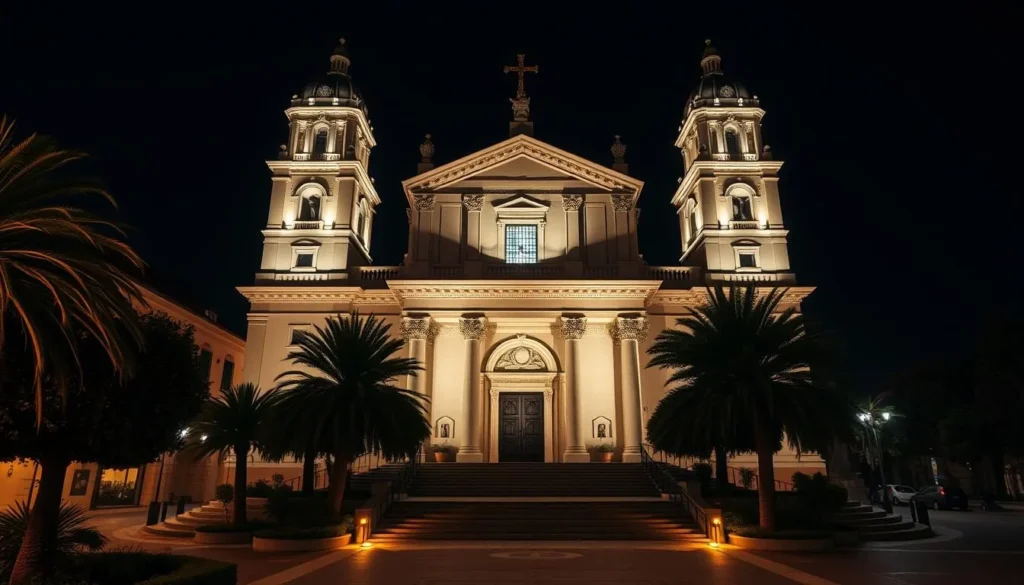
As you explore Ajaccio, you’ll discover the stunning San Roccu Cathedral, a testament to the city’s historical significance. This 19th-century neoclassical style cathedral is located on one of the main arteries of the city and is a prominent landmark.
Neoclassical Architecture and History
The San Roccu Cathedral stands as one of Ajaccio’s most important religious landmarks, showcasing impressive 19th-century neoclassical architecture that reflects the city’s historical significance. You’ll be struck by the cathedral’s imposing façade with its classical columns and symmetrical design, which was inspired by Italian Renaissance churches rather than traditional French cathedral styles.
Interior Highlights and Visiting Tips
When you visit the interior, take time to admire the ornate ceiling paintings, marble altars, and the remarkable pipe organ that dates back to the 19th century and still features in occasional concerts. For the best experience, plan your visit during morning hours when sunlight streams through the stained glass windows, creating beautiful patterns on the stone floors.
The cathedral’s recently renovated bell tower and roof have enhanced its appearance, and in the evening, the illuminated building creates a magical atmosphere in the heart of the city. Photography enthusiasts will appreciate both the exterior views from the small square in front of the cathedral and the interior architectural details that showcase the craftsmanship of the period.
Place De Gaulle and Napoleon Monument
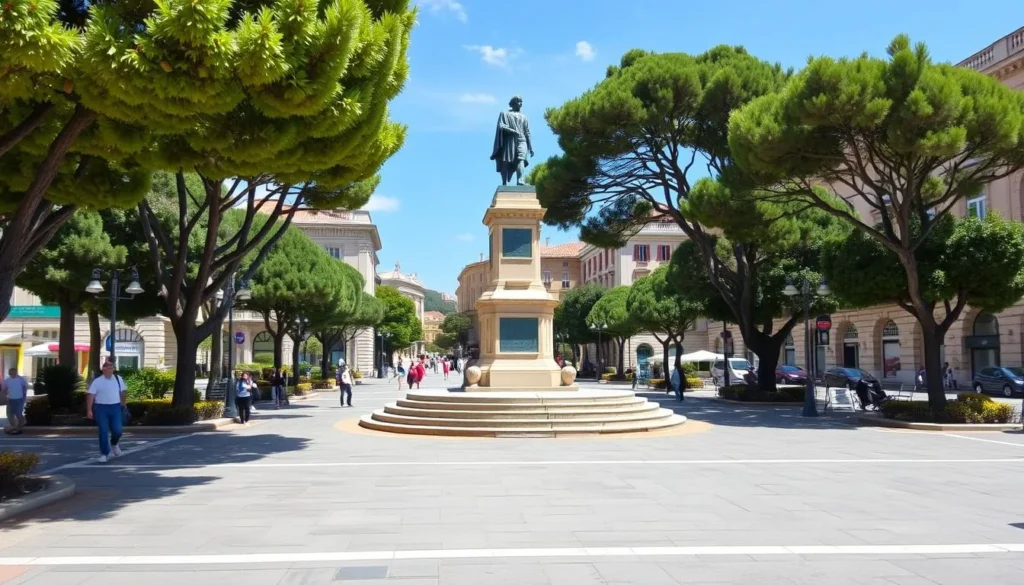
At the heart of Ajaccio lies Place De Gaulle, a square that seamlessly combines the city’s imperial past with its lively present. This vibrant square is not only a historical landmark but also a hub for family-friendly activities, making it a must-visit destination for travelers of all ages.
Family-Friendly Activities in the Square
The square is a delight for children, with a traditional carousel operating year-round, offering a charming old-world experience. You can also find kiosks selling treats like hot chocolate, ice cream, pancakes, and waffles, making it easy to satisfy your cravings while taking in the lively atmosphere. There’s ample space for kids to skate or ride a bike under the watchful eye of the monumental statue of Napoleon and his four brothers.
The Emperor’s Statue and Sea Views
One of the square’s hidden treasures is the spectacular sea view from behind the Napoleon statue. Step around to the back to discover a panoramic view of the Gulf of Ajaccio, a vista that many visitors miss. The impressive statue of Napoleon Bonaparte standing with his four brothers dominates the square, providing a powerful reminder of the city’s most famous son and his family legacy.
As you enjoy the square, notice how it transforms throughout the day – mornings bring locals rushing to work, afternoons see families with children enjoying ice cream, and evenings attract couples and friends strolling after dinner. The square is lined with cafes, making it a perfect spot to relax and take in the surroundings.
The Miollis Citadel: Ajaccio’s Historic Fortress
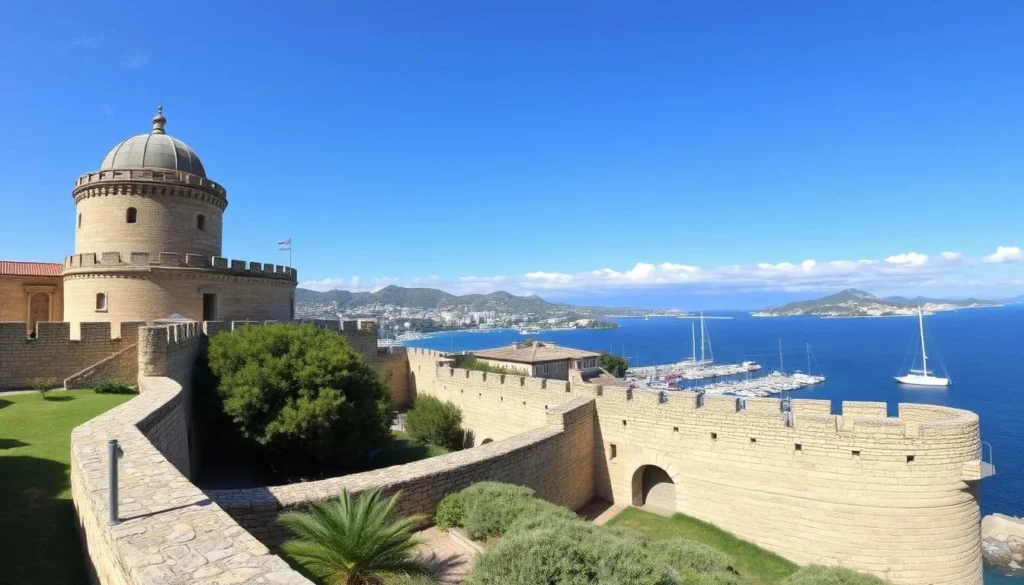
Ajaccio’s rich history is embodied in the Miollis Citadel, built in 1492. For centuries, this fortress played a crucial role in the city’s defense, and its significance is still palpable today. As you explore the citadel, you’ll discover its massive stone walls and strategic position overlooking the harbor, offering insight into the defensive concerns of the time.
From Military Stronghold to Cultural Venue
Long occupied by the army, the Citadel of Ajaccio was ceded to the city in 2019. For the first time in five centuries, it now welcomes civilians. Today, it’s a creative residence and cultural venue, hosting artists, events, sound and light shows, and exhibitions. This transformation has breathed new life into the historic structure, making it a vibrant part of Ajaccio’s cultural landscape.
Events and Exhibitions to Experience
Throughout the year, the citadel hosts a diverse program of events, including contemporary art exhibitions, music performances, and historical reenactments. The contrast between the ancient stone architecture and modern artistic installations creates a fascinating dialogue between past and present. As you visit, you’ll experience the citadel’s rich history and cultural significance, making your trip to Ajaccio a memorable one in this century.
Guided tours offer fascinating insights into the fortress’s construction and its role in defending the city against various threats over the time. You’ll gain a deeper understanding of Ajaccio’s history and the citadel’s importance as a city landmark.
Sanguinaires Islands: A Natural Wonder

The Sanguinaires Islands, with their dramatic granite formations, are a natural wonder waiting to be discovered. Located just off the coast of Ajaccio, this archipelago is named for the reddish hue it takes on at sunset, giving it a “bloody” appearance – ‘sanguinaire’ means ‘bloodthirsty’ in French. The islands are not just a visual treat; they also house a 19th-century lighthouse on the Grand Sanguinaire, which remains crucial for navigation in the Gulf of Ajaccio.
The islands serve as an important ecological reserve, providing a protected habitat for rare seabirds and unique Mediterranean plant species adapted to the harsh, salty conditions. As you explore the area, you can enjoy the sea surrounding the islands, rich in marine life.
How to Reach the Islands
You can reach the Sanguinaires Islands via regular boat tours that depart from Ajaccio’s port. The journey takes approximately 20-30 minutes each way, offering spectacular views of the coastline. For a great view, consider visiting Pointe de la Parata, the best vantage point on the mainland.
Best Viewpoints and Activities
For photography enthusiasts, the late afternoon is the best time to capture the islands as the setting sun bathes them in golden light, creating the famous blood-red effect. Activities around the islands include hiking the coastal paths, swimming in the crystal-clear waters of nearby beaches, and exploring the rich marine life through snorkeling or diving excursions. At a certain point, you can enjoy the serene atmosphere of the islands.
The Old Port: Maritime Heritage and Fresh Seafood
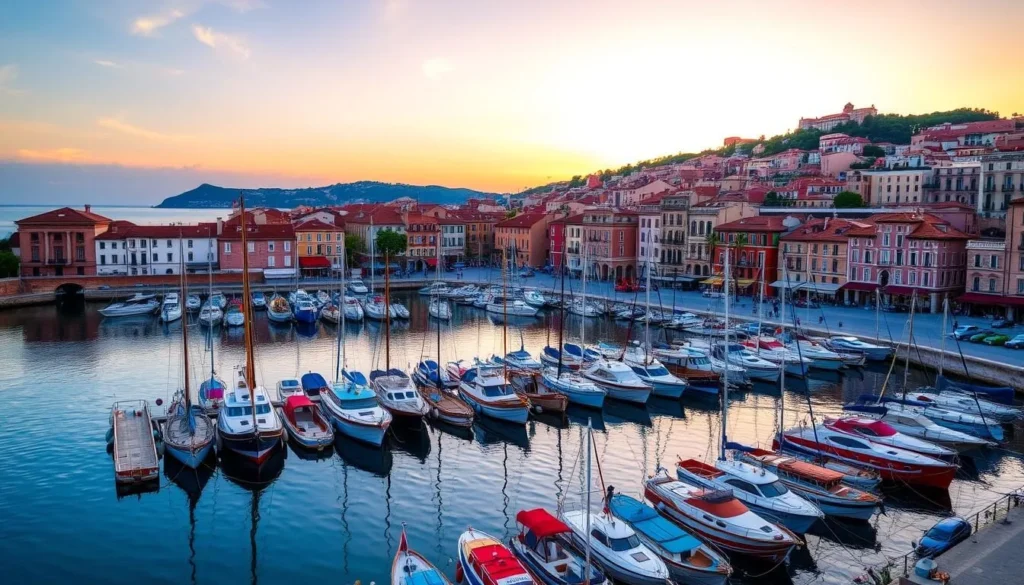
As you step into Ajaccio’s Old Port, you’re immediately immersed in a world of fishing traditions and local culture. The Old Port represents the beating heart of the city’s maritime heritage, where centuries-old fishing practices thrive alongside modern yachting culture.
Watching Local Fishermen at Work
Early mornings at the port offer the most authentic experience as you’ll find local fishermen returning with their catch of the day. You’ll see colorful nets filled with Mediterranean treasures like sea urchins, red mullet, and dentex. The fishing boats themselves are worth admiring – many are traditional wooden vessels painted in bright colors, reflecting the deep connection between Corsican families and the sea.
Seafood Restaurants and Waterfront Dining
Seafood enthusiasts will be delighted by the restaurants lining the port, where the concept of “sea-to-table” is a way of life. You’ll find a range of dining options, from humble family-run eateries serving simple grilled fish to more upscale venues offering sophisticated preparations of local food paired with Corsican wines. Whether you’re looking to dine on fresh catches or simply enjoy the view, the Old Port has something for everyone.
Visiting the Old Port is a sensory experience, with the day unfolding with the rhythm of the fishermen’s activities. Whether you’re there to witness the morning catch or enjoy the evening ambiance, you’ll ‘ll find that the Old Port is a captivating destination that showcases the best of Ajaccio’s maritime heritage.
Place d’Austerlitz and Napoleon’s Childhood
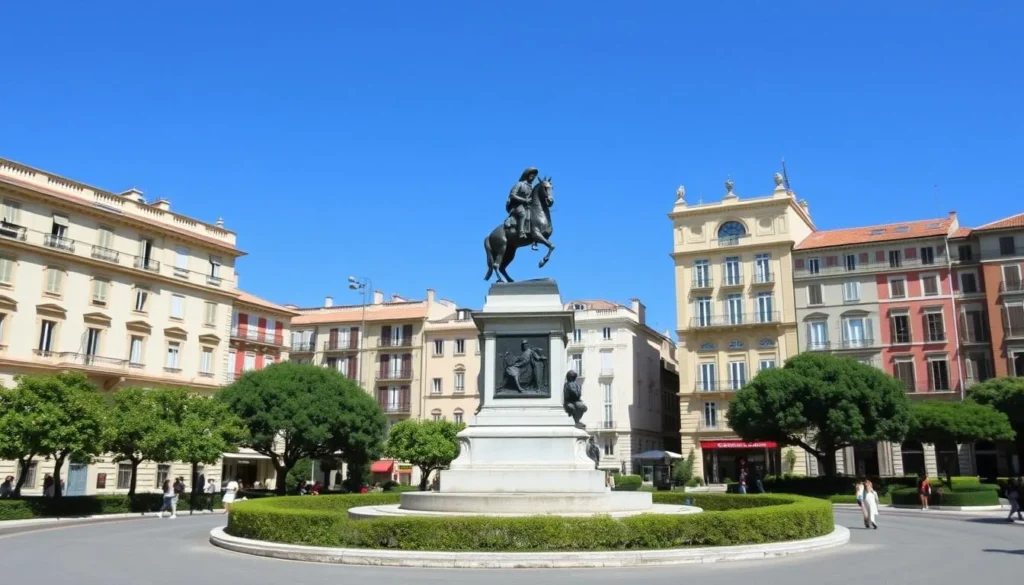
Ajaccio’s Place d’Austerlitz is a historic landmark that offers a glimpse into the formative years of Napoleon. Known locally as Place du Casone, this square is where the young Napoleon played, unaware of the destiny that awaited him. The square is dominated by an imposing statue of Napoleon, a replica of the one found at Les Invalides in Paris, symbolizing his imperial grandeur.
The Historic Grotto and Monuments
Near the square lies a historic grotto that held special significance for Napoleon, who reportedly spent time there contemplating and developing his strategic thinking. The area around the square is lined with magnificent plane trees, providing shade and a serene atmosphere. You can also spot the 19th-century Palais Lantivy, now housing the Corsican Prefecture, adding to the historical ambiance.
Summer Concerts and Cultural Events
During summer, Place du Casone transforms into a vibrant cultural venue, hosting open-air concerts featuring French and international artists. This blend of history and contemporary culture creates a unique atmosphere, making it a must-visit destination. As you stroll through the square, you’ll be surrounded by the emperor‘s legacy, making it a fascinating part of Ajaccio’s heritage.
Practical Tips for Visiting Ajaccio
As you prepare to visit Ajaccio, here are some essential tips to enhance your journey. Ajaccio, being the capital of Corsica and the birthplace of Napoleon Bonaparte, offers a rich historical and cultural experience.
Getting Around
Ajaccio’s historic center is compact and easily explored on foot, making it the most rewarding way to discover its hidden gems. For those with mobility concerns, the tourist train provides an excellent overview of major sites. Electric bikes are also a popular option for exploring beyond the city center, reaching places like the Sanguinaires Islands viewpoint.
| Mode of Transport | Best for | Notable Benefits |
|---|---|---|
| Walking | Historic Center | Discovering hidden gems, local culture |
| Tourist Train | Mobility Concerns | Overview of major sites, minimal exertion |
| Electric Bikes | Beyond City Center | Reaching Sanguinaires Islands, scenic views |
Best Time to Visit
The best time to visit Ajaccio is during the shoulder seasons (May-June and September-October), when you’ll find pleasant temperatures and fewer crowds. This period allows for a more relaxed exploration of the city’s attractions.
Where to Stay
Ajaccio offers a range of accommodations, from luxury waterfront hotels to charming guesthouses in the old town. Booking in advance is advisable, especially during peak summer season, to secure the best rates.
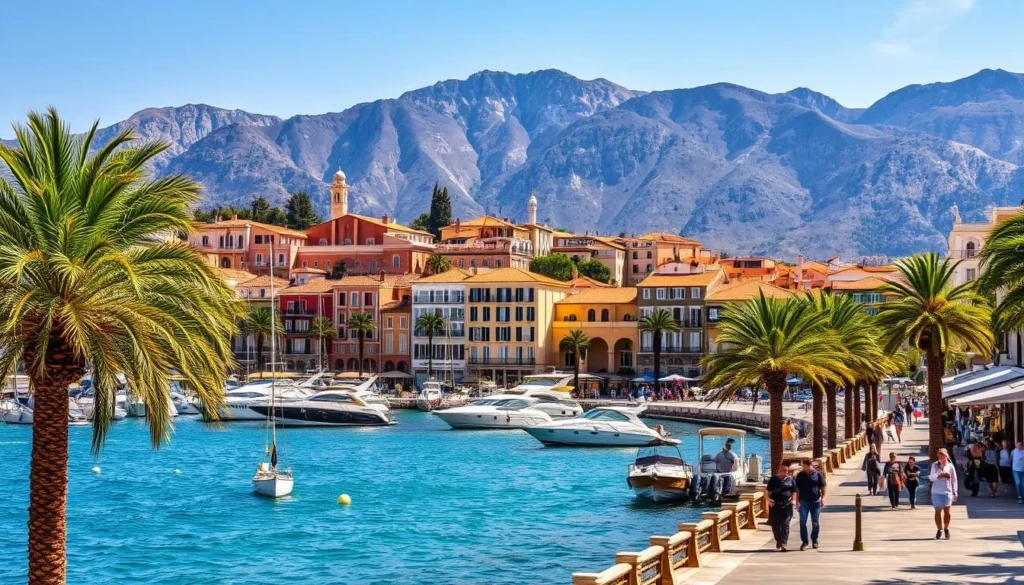
Conclusion: The Timeless Charm of Ajaccio
With its unique blend of Corsican culture and Napoleonic legacy, Ajaccio stands out as a must-visit destination. As you visit Ajaccio, you’ll be captivated by its imperial history and Mediterranean beauty. From the historic Maison Bonaparte to the breathtaking Sanguinaires Islands, the city’s diverse attractions leave a lasting impression.
The city’s beautiful beaches and crystal-clear sea offer the perfect setting for relaxation. Whether you’re drawn by history, cuisine, or simply the laid-back Mediterranean lifestyle, Ajaccio has something special to offer. As you plan your day, remember to take your time to wander and discover the city’s hidden gems, making your visit to this Corsican capital truly unforgettable.
The above is subject to change.
Check back often to TRAVEL.COM for the latest travel tips and deals.
